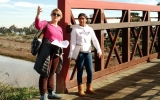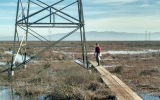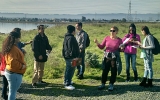High school students learn the risks from climate change; say more in their generation need to get involved.

Students from Redwood High School, led by coastal advocate Christina Conklin (left), visit East Palo Alto to learn about the threat of rising seas to our coastal communities.
CEOs, product engineers, marketers and investors take note: nearly every student in Chris Beetley-Hagler’s class at Redwood High School raised a hand when asked if he or she would chose to drive a low- or zero-emissions car.
No, not a high-performance all-electric Tesla S or the sporty Chevrolet Volt hybrid. No, we’re talking about an everyday ride with all of the appeal of a golf cart.
“If it helps make a difference, I’ll be down,” said 17-year-old Lo Letatau.
The "difference" she wants to make is slowing or halting rising seas that threaten her home town of East Palo Alto. Images of San Francisco Bay gradually engulfing her community are enough to prompt her to reassess her wants and needs based on greenhouse gas emissions and carbon footprints.
It's a new way of thinking for Letatau and many of her classmates. She and other Redwood students learned about the risks of climate change during an experimental educational program called Youth Exploring Sea Level Rise Science, or YESS. Approximately 100 students from Redwood, Woodside High School and Half Moon Bay High School studied the science behind global warming, visited vulnerable sites and performed surveys in spring 2016 to learn about climate change and its future impacts.

Many students said they knew little of climate change and sea level rise until embarking on a field trip to East Palo Alto's marshes and levees.
The pilot program was funded by the California Coastal Commission along with a $12,000 grant approved by the San Mateo County Board of Supervisors in October 2015. (Read the report.) Those funds come from Measure A, the countywide half-cent sales tax approved by voters in November 2012.
With the Pacific Ocean to the west and the bay to the east, San Mateo County is vulnerable to rising seas with billions of dollars of assets – homes, businesses, highways, bridges and more – at risk.
“This is a huge challenge we all face, and the ones who will be most impacted by climate change are our youth,” said San Mateo County Supervisor Don Horsley, who recommended funding the project. “Our goal is that young people understand this is a real problem and they have a real role to play in both combatting climate change and managing the impacts.”
54% of teens surveyed are "concerned or very concerned" about rising seas.
In response, the County has launched Sea Change San Mateo County, an initiative run by the County’s Office of Sustainability and the offices of Supervisors Horsley and Dave Pine. The goal is to promote collaboration among all government agencies and the private sector to find effective solutions and raise awareness. The County received a grant from the State Coastal Conservancy to help launch the effort.

Students explore the marshlands that separate much of East Palo Alto from the bay.
That effort also includes providing educational opportunities for high school students to learn about climate change and sea level rise.
"Before this, I never even heard about it," said Sione Feao, an 18-year-old East Palo Alto resident and Redwood student. "Everyone needs to learn about it because this is real."
Marina Psaros, director of the YESS project, is developing a curriculum focusing on climate change and sea level rise that can be taught in California science classes. Psaros led the Redwood students on a field trip to see what areas of East Palo Alto are most at risk. The bayside city is considered particularly vulnerable because much of it is protected from rising seas by only a levee.
In a discussion about what they learned by studying the science behind climate change and visiting vulnerable sites, students in Beetley-Hagler's Room 5 said more needs to be done to educate their generation about climate change and ways to combat it. They, after all, are the ones who will inherit the problem and will be forced to cope with the impacts.
One immediate idea they had was to launch a fund-raising campaign to both raise awareness about the threats and to help local residents buy flood insurance or even relocate.
What about simply building higher levees or stronger sea walls?
"You don't need to build anything if you change the way you live," said 16-year-old John Pohiva. "It's all about the choices we make."
Published on June 20, 2016:

John Pohiva
Note: The students presented their findings and recommendations to the Board of Supervisors in May 2016. View the presentation.
County officials are considering expanding the YESS program in the 2016-17 school year.
Want to learn more about how Measure A funds are impacting parks and the environment?
Click here for updates and archived stories on our Measure A initiatives.